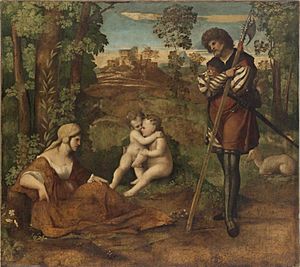Sir James Wright, 1st Baronet facts for kids
Sir James Wright (born 1730, died 1804) was an important British diplomat and art collector. A diplomat is someone who represents their country in another country. Sir James was the ambassador for Great Britain in Venice, Italy, from 1766 to 1774. An ambassador is the highest-ranking diplomat. He was also given the special title of Baronet.
Contents
Early Life and Family
Sir James Wright was the son of James Wright and Mary Huband. He was born in Warwick, England, and was baptised on April 8, 1730. He had a brother named John and two sisters, Mary and Jane.
- His sister Mary married a doctor named Rice Charleton.
- His sister Jane married John Moore, who later became the Archbishop of Canterbury. An Archbishop is a very high-ranking leader in the Church of England.
His father owned land in places like Cubbington and Butlers Marston. Sir James's mother's family, the Hubands, were also from an important family in Warwickshire.
First Time in Italy
Sir James Wright and his wife, Catherine, first visited Venice in December 1758. While there, they met Lady Mary Wortley Montagu, a famous writer. She introduced them to Lord Bute, who later became the Prime Minister of Great Britain.
Sir James and Catherine were very close. Lady Mary noticed how they comforted each other when they lost a child. This made her think of her friends, the Bute family. Catherine Wright even became Lady Mary's pen pal.
Sir James became good friends with Lord Bute. This friendship helped him get a job as a Groom of the Bedchamber to King George III. This was a special role helping the King. He worked for the King from 1762 to 1801 and was knighted in 1766.
Diplomat in Venice
Sir James Wright arrived in Venice as the British Resident in September 1766. A Resident was a diplomat who lived in a foreign country to represent their home country.
While in Venice, both Sir James and his wife became ill. They returned to England for about two years, from 1769 to 1771. During this time, another person, Robert Richie, took over Sir James's duties.
For his good work as a diplomat, Sir James was given the title of Baronet on October 12, 1772. The Wrights left Venice in 1773, and his job there officially ended in 1774.
Later Life and Art Collection
Around 1770, Sir James Wright bought a large house called Ray House in Woodford, England. He hired a famous architect, Robert Adam, to work on the house.
Sir James used Ray House to display his large collection of paintings. He bought many artworks during his time in Venice. He was also an art dealer, meaning he bought and sold art. He bought a famous painting called The Finding of Moses by Giambattista Tiepolo for Lord Bute. This painting is now in the National Gallery of Scotland.
Being in Venice helped Sir James become an expert in paintings. He also became a patron of artists, meaning he supported them by commissioning portraits. He had portraits painted by artists like Robert Fagan, Joshua Reynolds, and Johann Zoffany.
Sir James also started a business making artificial slate on his land in Woodford. He bought the idea from a patent in 1776 and improved the process using ideas from Italy. He also bought other nearby properties, like Monkham house and farm.
Sir James's Family
Sir James Wright married Catherine Stapleton in London on December 9, 1754. Catherine's family owned sugar plantations in the West Indies. After some legal matters were sorted out, Sir James received a share of these properties.
Sir James and Catherine had a son named George Ernest James Wright. He was born in 1770. George later married Rebecca Maclane in 1796. His uncle, John Moore (the Archbishop of Canterbury), performed the wedding ceremony.
George and Rebecca had a daughter named Ruperta Maria, who sadly died very young. Their only other child was Ruperta Catherine. She married Edward Murray, who was a vicar (a type of priest).
Sir James also built another house called Ray Lodge near Ray House for his son George. He hired an architect named John Buonarotti Papworth for this project.
End of Life
Lady Catherine Wright died in 1802. Sir James Wright died in 1804.
After Sir George Wright died around 1812, the special title of Baronet ended. The artificial slate business also closed around 1811. Ray House, the mansion Sir James owned, was destroyed by fire in 1838.


